編輯:Android資訊
Android平台有三種網絡接口可以使用,他們分別是:java.net.*(標准Java接口)、Org.apache接口和Android.net.*(Android網絡接口)。下面分別介紹這些接口的功能和作用。
java.net.*提供與聯網有關的類,包括流、數據包套接字(socket)、Internet協議、常見Http處理等。比如:創建URL,以及URLConnection/HttpURLConnection對象、設置鏈接參數、鏈接到服務器、向服務器寫數據、從服務器讀取數據等通信。這些在Java網絡編程中均有涉及,我們看一個簡單的socket編程,實現服務器回發客戶端信息。
下面用個例子來說明:
A、客戶端:
新建Android項目工程:SocketForAndroid(這個隨意起名字了吧,我是以這個建立的!)
下面是main_activity.xml的代碼:
<?xml version="1.0" encoding="utf-8"?> <LinearLayout xmlns:android="http://schemas.android.com/apk/res/android" android:layout_width="fill_parent" android:layout_height="fill_parent" android:orientation="vertical"> <TextView android:layout_width="fill_parent" android:layout_height="wrap_content" android:text="@string/hello" /> <EditText android:id="@+id/message" android:layout_width="match_parent" android:layout_height="wrap_content" android:hint="@string/hint" /> <Button android:id="@+id/send" android:layout_width="fill_parent" android:layout_height="wrap_content" android:text="@string/send" /> </LinearLayout>
MainActivity.java的代碼入下:
package com.yaowen.socketforandroid;
import android.os.Bundle;
import android.support.v7.app.AppCompatActivity;
import android.view.View;
import android.widget.Button;
import android.widget.EditText;
import java.io.BufferedReader;
import java.io.BufferedWriter;
import java.io.IOException;
import java.io.InputStreamReader;
import java.io.OutputStreamWriter;
import java.io.PrintWriter;
import java.net.Socket;
public class MainActivity extends AppCompatActivity {
private EditText message;
private Button send;
@Override
protected void onCreate(Bundle savedInstanceState) {
super.onCreate(savedInstanceState);
setContentView(R.layout.activity_main);
//初始化兩個UI控件
message = (EditText) findViewById(R.id.message);
send = (Button) findViewById(R.id.send);
//設置發送按鈕的點擊事件響應
send.setOnClickListener(new View.OnClickListener() {
@Override
public void onClick(View v) {
Socket socket = null;
//獲取message輸入框裡的輸入的內容
String msg = message.getText().toString() + "/r/n";
try {
//這裡必須是192.168.3.200,不可以是localhost或者127.0.0.1
socket = new Socket("192.168.3.200", 18888);
PrintWriter out = new PrintWriter(
new BufferedWriter(
new OutputStreamWriter(
socket.getOutputStream()
)
), true);
//發送消息
out.println(msg);
//接收數據
BufferedReader in = new BufferedReader(
new InputStreamReader(
socket.getInputStream()
)
);
//讀取接收的數據
String msg_in = in.readLine();
if (null != msg_in) {
message.setText(msg_in);
System.out.println(msg_in);
} else {
message.setText("接收的數據有誤!");
}
//關閉各種流
out.close();
in.close();
} catch (IOException e) {
e.printStackTrace();
} finally {
try {
if (null != socket) {
//socket不為空時,最後記得要把socket關閉
socket.close();
}
} catch (IOException e) {
e.printStackTrace();
}
}
}
});
}
}
最後別忘記添加訪問網絡權限:
<uses-permission android:name="android.permission.INTERNET" />
B、服務端:
package service;
import java.io.BufferedReader;
import java.io.BufferedWriter;
import java.io.IOException;
import java.io.InputStreamReader;
import java.io.OutputStreamWriter;
import java.io.PrintWriter;
import java.net.ServerSocket;
import java.net.Socket;
public class ServerAndroid implements Runnable {
@Override
public void run() {
Socket socket = null;
try {
ServerSocket server = new ServerSocket(18888);
// 循環監聽客戶端鏈接請求
while (true) {
System.out.println("start...");
// 接收請求
socket = server.accept();
System.out.println("accept...");
// 接收客戶端消息
BufferedReader in = new BufferedReader(new InputStreamReader(socket.getInputStream()));
String message = in.readLine();
System.out.println(message);
// 發送消息,向客戶端
PrintWriter out = new PrintWriter(new BufferedWriter(new OutputStreamWriter(socket.getOutputStream())),
true);
out.println("Server:" + message);
// 關閉流
in.close();
out.close();
}
} catch (IOException e) {
e.printStackTrace();
} finally {
if (null != socket) {
try {
socket.close();
} catch (IOException e) {
e.printStackTrace();
}
}
}
}
// 啟動服務器
public static void main(String[] args) {
Thread server = new Thread(new ServerAndroid());
server.start();
}
}
C、啟動服務器,控制台會打印出“start…”字符串!
D、運行Android項目文件,如下圖:
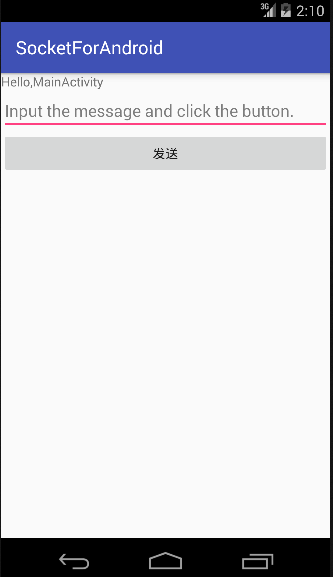
在輸入框裡輸入如下字符串,點發送按鈕:
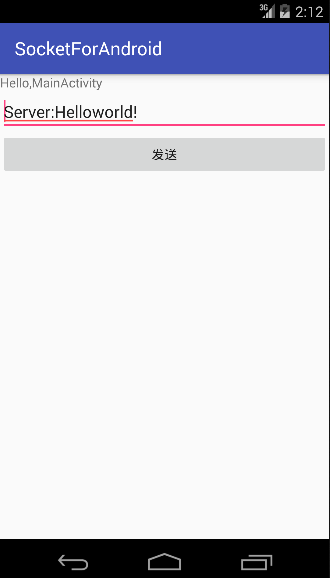
服務器收到客戶端發來的消息並打印到控制台:

對於大部分應用程序而言JDK本身提供的網絡功能已遠遠不夠,這時就需要Android提供的Apache HttpClient了。它是一個開源項目,功能更加完善,為客戶端的Http編程提供高效、最新、功能豐富的工具包支持。
下面我們以一個簡單例子來看看如何使用HttpClient在Android客戶端訪問Web。
首先,要在你的機器上搭建一個web應用test,有兩個很簡單的PHP文件:hello_get.php和hello_post.php!
內容如下:
hello_get.php的代碼如下:
<html> <body> Welcome <?php echo $_GET["name"]; ?><br> You connected this page on : <?php echo $_GET["get"]; ?> </body> </html>
hello_post.php的代碼如下:
<html> <body> Welcome <?php echo $_POST["name"]; ?><br> You connected this page on : <?php echo $_POST["post"]; ?> </body> </html>
在原來的Android項目裡新建一個Apache活動類:Apache.java,代碼如下:
package com.yaowen.socketforandroid;
import android.os.Bundle;
import android.support.v7.app.AppCompatActivity;
import android.view.View;
import android.widget.Button;
import android.widget.TextView;
import org.apache.http.HttpEntity;
import org.apache.http.HttpResponse;
import org.apache.http.NameValuePair;
import org.apache.http.client.ClientProtocolException;
import org.apache.http.client.HttpClient;
import org.apache.http.client.entity.UrlEncodedFormEntity;
import org.apache.http.client.methods.HttpGet;
import org.apache.http.client.methods.HttpPost;
import org.apache.http.impl.client.DefaultHttpClient;
import org.apache.http.message.BasicNameValuePair;
import java.io.BufferedReader;
import java.io.IOException;
import java.io.InputStreamReader;
import java.io.UnsupportedEncodingException;
import java.util.ArrayList;
import java.util.List;
/**
* Created by YAOWEN on 2015/11/10.
*/
public class ApacheActivity extends AppCompatActivity implements View.OnClickListener {
private TextView textView;
private Button get1, post1;
@Override
protected void onCreate(Bundle savedInstanceState) {
super.onCreate(savedInstanceState);
setContentView(R.layout.apache);
textView = (TextView) findViewById(R.id.textView);
get1 = (Button) findViewById(R.id.get);
post1 = (Button) findViewById(R.id.post);
get1.setOnClickListener(this);
post1.setOnClickListener(this);
}
@Override
public void onClick(View v) {
if (v.getId() == R.id.get) {
//注意:此處ip不能用127.0.0.1或localhost,Android模擬器已將它自己作為了localhost
String url = "http://192.168.3.200/test/hello_get.php?name=yaowen&get=GET";
textView.setText(get(url));
}
if (v.getId() == R.id.post) {
String url="http://192.168.3.200/test/hello_post.php";
textView.setText(post(url));
}
}
/**
* 以post方式發送請求,訪問web
*
* @param url web地址
* @return 響應數據
*/
private String post(String url) {
BufferedReader reader = null;
StringBuffer sb = null;
String result = "";
HttpClient client = new DefaultHttpClient();
HttpPost requset = new HttpPost(url);
//保存要傳遞的參數
List<NameValuePair> params = new ArrayList<NameValuePair>();
//添加參數
params.add(new BasicNameValuePair("name", "yaowen"));
params.add(new BasicNameValuePair("post","POST"));
try {
HttpEntity entity = new UrlEncodedFormEntity(params, "utf-8");
requset.setEntity(entity);
HttpResponse response = client.execute(requset);
if (response.getStatusLine().getStatusCode() == 200) {
System.out.println("post success");
reader = new BufferedReader(new InputStreamReader(response.getEntity().getContent()));
sb = new StringBuffer();
String line = "";
String NL = System.getProperty("line.separator");
while ((line = reader.readLine()) != null) {
sb.append(line);
}
}
} catch (UnsupportedEncodingException e) {
e.printStackTrace();
} catch (ClientProtocolException e) {
e.printStackTrace();
} catch (IOException e) {
e.printStackTrace();
} finally {
if (null != reader) {
try {
reader.close();
} catch (IOException e) {
e.printStackTrace();
}
}
if (null != sb) {
result = sb.toString();
}
}
return result;
}
/**
* 以get方式發送請求,訪問web
*
* @param url web地址
* @return 響應數據
*/
private static String get(String url) {
BufferedReader bufferedReader = null;
StringBuffer sb = null;
String result = "";
HttpClient client = new DefaultHttpClient();
HttpGet request = new HttpGet(url);
//發送請求,得到響應
try {
HttpResponse response = client.execute(request);
//請求成功
if (response.getStatusLine().getStatusCode() == 200) {
bufferedReader = new BufferedReader(
new InputStreamReader(
response.getEntity()
.getContent()
)
);
sb = new StringBuffer();
String line = "";
String NL = System.getProperty("line.separator");
while ((line = bufferedReader.readLine()) != null) {
sb.append(line);
}
}
} catch (IOException e) {
e.printStackTrace();
} finally {
if (null != bufferedReader) {
try {
bufferedReader.close();
//bufferedReader=null;
} catch (IOException e) {
e.printStackTrace();
}
}
if (null != sb) {
result = sb.toString();
}
}
return result;
}
}
新建一個apache.XML文件,如下:
<?xml version="1.0" encoding="utf-8"?> <LinearLayout xmlns:android="http://schemas.android.com/apk/res/android" android:layout_width="fill_parent" android:layout_height="fill_parent" android:orientation="vertical"> <TextView android:id="@+id/textView" android:layout_width="fill_parent" android:layout_height="wrap_content" android:gravity="center" android:text="通過按鈕選擇不同方式訪問網頁" /> <Button android:id="@+id/get" android:layout_width="match_parent" android:layout_height="wrap_content" android:text="get" /> <Button android:id="@+id/post" android:layout_width="match_parent" android:layout_height="wrap_content" android:text="post" /> </LinearLayout>
結果運行如下:
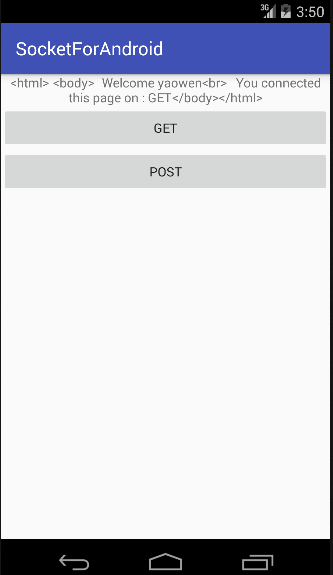
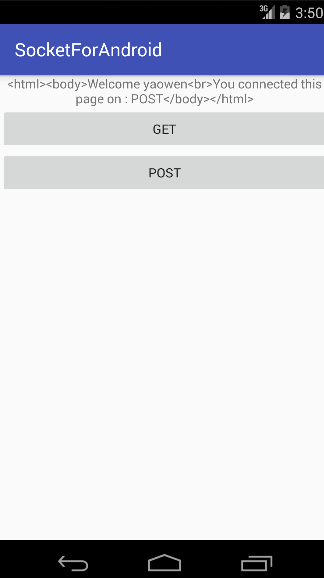
常常使用此包下的類進行Android特有的網絡編程,如:訪問WiFi,訪問Android聯網信息,郵件等功能。
這裡就不詳細做例子了,因為這個接觸比較多~~~。
 深入理解 Android 動畫 Interpolator 類的使用
深入理解 Android 動畫 Interpolator 類的使用
做過android動畫的人對Interpolator應該不會陌生,這個類主要是用來控制android動畫的執行速率,一般情況下,如果我們不設置,動畫都不是勻速執行
 Android 鍵盤監控的實現原理及過程
Android 鍵盤監控的實現原理及過程
鍵盤監控 鍵盤監控,顧名思義是在應用軟件在運行時,用戶在設備上的一舉一動都將被詳細記錄下來,更多的實在使用者毫無覺察的情況下將屏幕內容以圖片的形式、按鍵內容以文本
 Android安全加密:HTTPS編程
Android安全加密:HTTPS編程
Android安全加密專題文章索引 Android安全加密:對稱加密 Android安全加密:非對稱加密 Android安全加密:消息摘要Message Dig
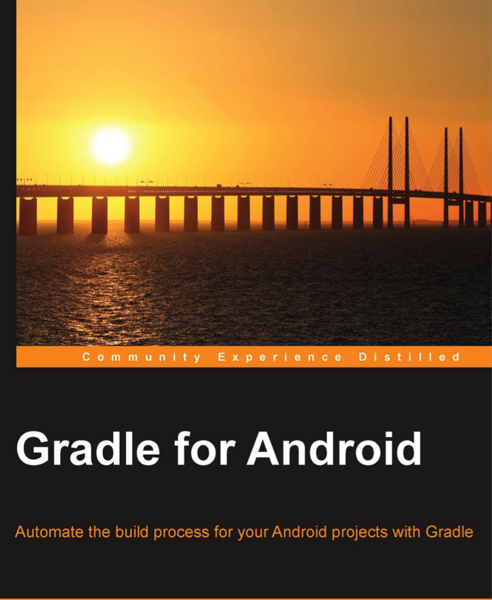 Gradle for Android 第一篇( 從 Gradle 和 AS 開始 )
Gradle for Android 第一篇( 從 Gradle 和 AS 開始 )
正如大家所見,這是本英文書,而由於國內的gradle翻譯資料不全,所以特次開辟專欄,翻譯gradle for android這本書,同時添加自己的心得體會以及在實